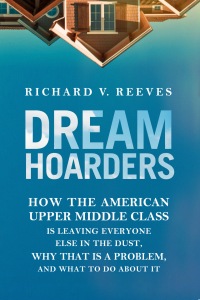Counting on Class: The Continuing Appeal of Meritocracy
Neither faith in nor critiques of the idea of meritocracy is new. Michael Young’s famous 1958 book The Rise of Meritocracy argued that class privilege and advantage were likely to be amplified as financial and cultural capital passed across generations in families. Each new generation would benefit from existing structural advantage created by their parents and even grandparents. They might be talented individuals, hardworking and driven to succeed, but they would owe their achievements in part to a myriad of inherited class advantages. Young intended the title of his book as a satire, but for many, it seems to promote the ideal of egalitarian opportunity.
A recent rash of books critically revisit the ideas in Young’s now six-decade-old book. In The Class Ceiling: Why it ays to be Privileged, Sam Friendman and Daniel Laurison provide a wonderfully accessible account of contemporary class analysis in the UK, examining the complex ways in which class influences life chances. The authors leaven the numbers with fascinating vignettes from the field showing how successful middle-class professionals are sometimes aware of their own class privilege. As one put it, “I was lucky to have a following wind”. The book does not offer a crude demonization of privilege. Instead, the study gets to the heart of how talent and hard work don’t sufficiently explain how good jobs get allocated. Often times, as The Class Ceiling shows, it’s the lucky breaks that already privileged people enjoy that allow them to achieve yet more success.
Take ‘Mark’ for example, a successful TV executive in his late thirties. Mark relates to Friedman and Laurison his own ‘following wind’. The son of successful educated professionals, he was privately educated before gaining a place at Oxford. While he was at Oxford, Mark’s parents paid for him to go on a holiday to New York to do research for his undergraduate dissertation. He stayed in Manhattan for free in an apartment owned by a contact his father had met on the side-lines of a rugby match. This same contact then provided Mark with an introduction to the television industry. The upside of the anecdote is that Mark is full aware of his privilege and luck.
The Class Ceiling is peppered with similar tales of advantage and their mirror image, such as the pairing of Nathan and Jim. Nathan’s CV is littered with prestigious roles in TV and film. He attributes his success to “just working incredibly hard” and “making good decisions” like turning down jobs he didn’t believe in. As he explains, “No job is worth sacrificing yourself for”. Jim, by contrast, has decided to leave the acting profession after ‘sacrificing’ himself and his career by taking the kind of parts Nathan can afford to avoid. Jim’s working-class origins still constrain him in his forties. He struggled so hard to get into the acting profession, but the typecast jobs he has to take ultimately end up damaging his career and lead to offers drying up altogether. Class both constrains and enables after all.
More ...


 We middle-class professionals are a crafty bunch, especially our intellectual elite. One of our cagiest moves recently involves our expressions of concern about increasing income and wealth inequality in the U.S. While eloquently expressing how guilty we feel about our privilege, we never come close to suggesting that some money be moved around. “Redistribution” is either not in our vocabulary or “something we need to discuss,” which is our standard way of ending discussion by putting it off to an indefinite future. But our craftiest move is how we routinely slip and slide in our discussion of the inequality of money (which is what income and wealth are) into ways to improve equality of opportunity.
We middle-class professionals are a crafty bunch, especially our intellectual elite. One of our cagiest moves recently involves our expressions of concern about increasing income and wealth inequality in the U.S. While eloquently expressing how guilty we feel about our privilege, we never come close to suggesting that some money be moved around. “Redistribution” is either not in our vocabulary or “something we need to discuss,” which is our standard way of ending discussion by putting it off to an indefinite future. But our craftiest move is how we routinely slip and slide in our discussion of the inequality of money (which is what income and wealth are) into ways to improve equality of opportunity. By Katie Wells, Kafui Attoh, and Declan Cullen
By Katie Wells, Kafui Attoh, and Declan Cullen America rediscovered its working class during the 2016 election, and many Democrats and progressives now call for fresh policies to address the nation’s crisis of bad jobs and stagnant wages. Twenty-first century working-class prosperity, however, must involve a reinvigorated labor movement. And women, especially women of color, will be more central than ever before.
America rediscovered its working class during the 2016 election, and many Democrats and progressives now call for fresh policies to address the nation’s crisis of bad jobs and stagnant wages. Twenty-first century working-class prosperity, however, must involve a reinvigorated labor movement. And women, especially women of color, will be more central than ever before. Freedom of religion is a central idea in the United States. Most descriptions of U.S. history emphasize flight from religious repression as the main motivation for colonial settlement. The U.S. Constitution enshrines the idea of freedom in the very first line of the First Amendment: “Congress shall make no law respecting an establishment of religion, or prohibiting the free exercise thereof.” Proponents argue that religious liberty means that everyone may participate in a free “marketplace” of religious ideas and practices. Neither atheists nor believers pay taxes to support a state church. Believers are free of taxes on property and activities associated with their church, temple, or mosque. In this open market, the benefits are said to be spread evenly – from the rich to the poor, from the 1% to the working class. However, institutional actions in the name of religious freedom can have negative consequences for working-class people.
Freedom of religion is a central idea in the United States. Most descriptions of U.S. history emphasize flight from religious repression as the main motivation for colonial settlement. The U.S. Constitution enshrines the idea of freedom in the very first line of the First Amendment: “Congress shall make no law respecting an establishment of religion, or prohibiting the free exercise thereof.” Proponents argue that religious liberty means that everyone may participate in a free “marketplace” of religious ideas and practices. Neither atheists nor believers pay taxes to support a state church. Believers are free of taxes on property and activities associated with their church, temple, or mosque. In this open market, the benefits are said to be spread evenly – from the rich to the poor, from the 1% to the working class. However, institutional actions in the name of religious freedom can have negative consequences for working-class people. Few rock music memoirs have caught the attention of esteemed novelists such as Richard Ford, whose
Few rock music memoirs have caught the attention of esteemed novelists such as Richard Ford, whose 



